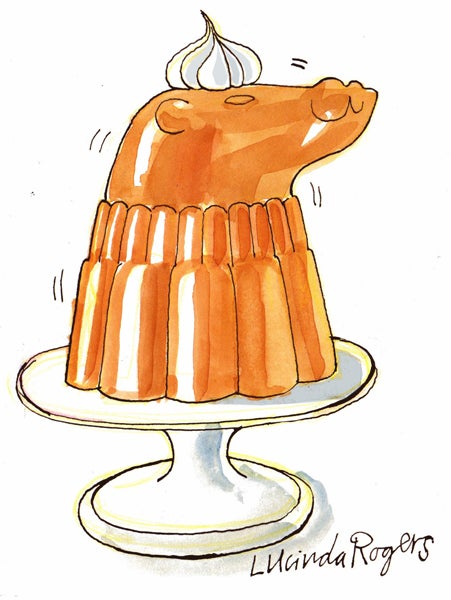The Weasel: Breaking the mould

Even though its infamous wobbliness is now firmly held in check, Lord Foster's Millennium Bridge continues to attract critical scrutiny. "How did they get it to stand up?" inquired a dubious Mrs W. "It must have been very stiff. A bit chewy I imagine." She had a point. The single-span crossing demands considerable material resilience. This is exactly what you want in a bridge, though it is rarely desirable in a raspberry jelly. It must be admitted that Mrs W's critique did not concern the "Blade of Light" as such. Her views were prompted by a gelatinous model of the structure from Foster & Partners. Apparently moulded in raspberry jelly (though it might have been the less satisfying strawberry version), it was one of the finalists in a jelly competition organised for the London Festival of Architecture, which runs until 20 July. Following an auction, successful bidders were able to spoon up all 10 on the short-list, including jellies of Nicholas Grimshaw's Eden Project and Richard Rogers's terminal at Madrid Airport.
One of the judges, Professor Stephen Gage of University College London's Bartlett School of Architecture, explained the rationale for the competition with the down-to-earth good sense for which his profession is renowned. "Part of our subconscious appreciation of shape may well be a dim memory of how it might feel in our mouth. Thus, a dome is round and coolly satisfying, while a pointed building is like a sharp and dangerous knife. Jelly architecture returns architecture to the mouth, where we can once again taste it." Though oral aesthetics offer a wealth of exciting new possibilities for architectural appreciation, the prof's statement suggests that the dessert course Chez Gage may be a trifle daunting or, possibly, a daunting trifle.
All a-quiver with excitement at the possibilities of architecture en gelée, I ordered an entire suburb from the jelly expert of Weasel Villas. Though she unaccountably failed to tremble with delight at the commission, Mrs W gathered a fine range of moulds for our Jellyopolis. They included several bulbous Victorian-style moulds that resembled Byzantine basilicas. Her other structures were more avant-garde. I couldn't say if any of our leading architects have designed a structure in the shape of a bunny rabbit or a pussycat.
For structural guidance, she turned to the pioneering materials scientist Isabella Beeton (1836-1865). This was in line with the competition jellies. "We want to bring back fine jelly, which features in the best Victorian banquets," said Sam Bompas of "architectural foodsmiths" Bompas & Parr, who organised the contest. "Our jellies are almost entirely composed of fresh fruit, so they are a low-calorie, diet-friendly dessert." What could be more fresh and lovely? Except that jellies have a dark side. Almost all are made using gelatine, which, according to Wikipedia, is "extracted from the bones, connective tissues, organs and some intestines of animals such as domesticated cattle and horses."
When I remarked on the magical metamorphosis of such grisly stuff into pelucid sheets of gelatine, Mrs W did not seem very interested. She was busy following Mrs Beeton's instruction to extract the juice from "about nine China oranges". When I expressed amazement that her fresh-orange jelly mix exactly filled the rabbit, the cool hauteur of Mrs W would have been appreciated at the Bauhaus. "I knew it would. I calculated it." The transformation of raspberries into jelly mix for the Byzantine cathedrals also passed without incident, but trouble came with the pussycat. At my request, Mrs W filled it with a Beeton recipe for "jeunemange", a sort of lemon jelly made with white wine and egg yolks. "Keep stirring the mixture one way until it thickens, but do not allow to boil," commanded Mrs Beeton. "Then take it off the fire and keep stirring until nearly cold."
Mrs W cussed Mrs B good and proper as she whirled her spoon clockwise. "I've been stirring for an hour now in one direction and it shows no sign of thickening," she huffed. "I'm getting a blister on my finger." Gelatinous architecture may be all the rage, but I can't imagine milords Foster and Rogers stirring jelly any more than they would mix the concrete for their grands projets. "It's thinner now than it was when I took it off the hob," she groaned, while putting the cat in the fridge. "We won't know till it sets if it's going to set." I'd guess that similar words, give or take an expletive, have been said on many a building site.
"Never mind, darling," I replied. "If you haven't made a cat-shaped building, you'll have made a cat-shaped lake." She gave me a sour look.
****
As Mrs W had anticipated, the orange bunny was a great success. It emerged from the mould with a satisfactory slurp and quivered like a real rabbit. Moreover, it delivered a delicious bittersweet tang to the palate. Same with the Byzantine raspberry jelly. Tart, fresh, zingy, it was the jellified essence of summer. Finally, the moment arrived for the unveiling of the pussycat.
A triumph! Out of the mould plopped a perfect yellow feline. Its taste was a genre-busting lemony custard, as enigmatic as the Sphinx it resembled.
Flipping the pages of Mrs Beeton, I came across another exciting possibility. "Do you want to do her 'jelly of two colours'?" The creative genius of Weasel Villas responded in no uncertain terms that she'd had enough of jelly. Maybe she had a point. All great architects relish a new challenge. "How about blancmange?"
Join our commenting forum
Join thought-provoking conversations, follow other Independent readers and see their replies
Comments
Bookmark popover
Removed from bookmarks